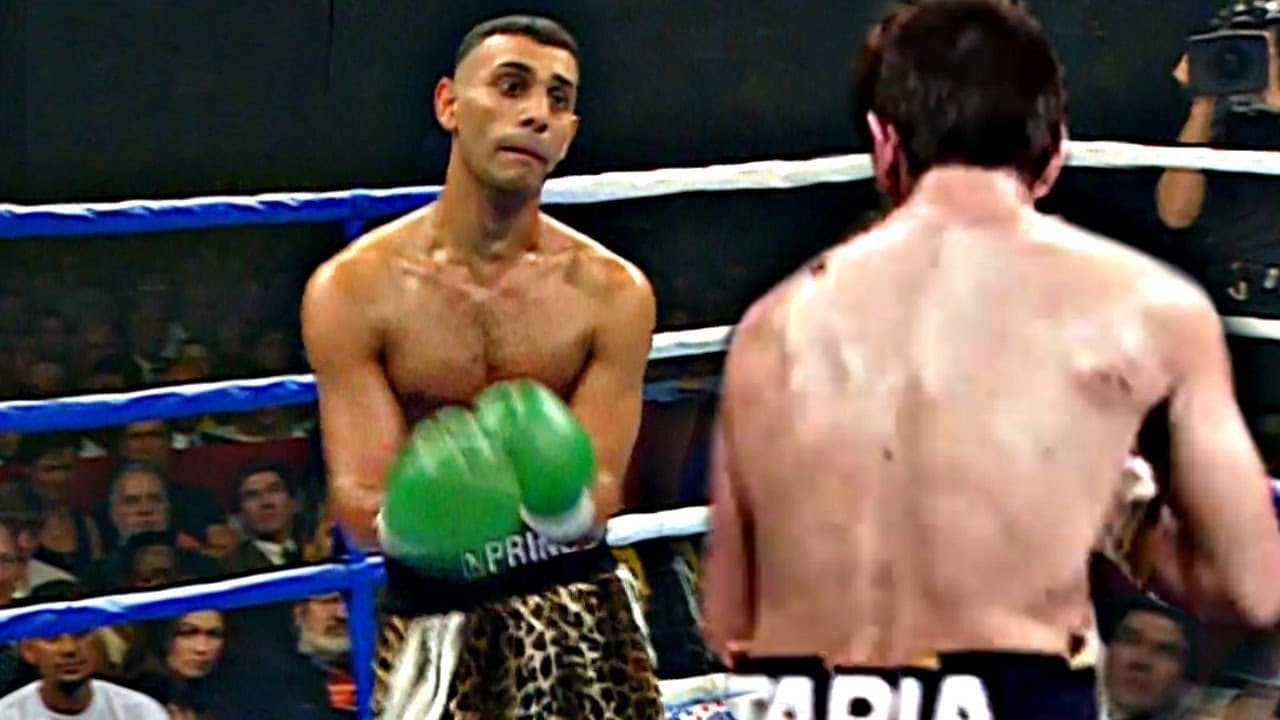Born today in The Steel City of Sheffield in the south of Yorkshire, England, was one Naseem Hamed – better known in boxing circles as Naz, or “The Prince”. A superbly reflexive acrobat of a concussive puncher, this featherweight star who shone ever so brightly, but ever so briefly, still polarises opinion all these years on from his quiet, unannounced, retirement from the sport.
Today, virtually unrecognizable from his fighting days (maybe around 60 pounds or a whole lot more above the featherweight limit is the rich, content and still-smug Naz these days), Hamed is often recalled by fight fans; or debated by fight fans. How good was Hamed? Could he even have been a great?
In the UK, at the time of Hamed’s wins over European-level bantamweights and WBC fringe contenders at super-bantamweight, commentators who should have known better were showering the 20 year old with all manner of praise, stating on air how the flash and supremely cocky prospect could literally switch punches in mid-air: from a jab to an uppercut, for example. Sure, Naz could punch, as well as move, do somersaults, taunt his over-matched opponents and end his fights in quick fashion.
And he was soon getting people talking; hard-core fight fans and casuals alike. Hamed did step up in quality of opposition, and big wins over the likes of Steve Robinson (Hamed’s first world title win, the WBO belt), Said Lawal, Daniel Alicea, Manuel Medina, Remigio Molina (you are forgiven if you fail to remember most of these fighters), Tom Johnson (a genuinely meaningful win for Naz, perhaps the first of his career at that point, although the grizzled Medina was tough as old boots), Billy Hardy, Juan Cabrera and Jose Badillo kept the hype-train/gravy-train running at top speed. But then Hamed, under pressure to face elite fighters, met Kevin Kelley in his U.S debut.
To his credit, a crushing loss was averted due to: Hamed’s ability to take a shot, his get-out-of-jail power, and the fact that 30 year old Kelley had 50 fights on his body, compared to 28 pro bouts for the 23 year old Hamed. But now the cracks were appearing, and in full view. Downed three times in the thrilling fight, Hamed was oh, so close to getting sent back to the UK as an exposed fighter. This would actually happen in 2001, just seven fights later.
Decent wins over (a faded) Wilfredo Vazquez, (a too-small) Wayne McCullough, Paul Ingle, Cesar Soto and a still-raw Augie Sanchez followed, before Hamed finally faced an elite-level, in his prime opponent: Marco Antonio Barrera. Not that Team-Hamed felt the Mexican warrior (who surprised them all by switching into clever boxer mode for the April 2001 fight) was still as good as he had been. Barrera had been stopped (officially by DQ) by Junior Jones, Marco had gone through sheer hell in a war with his countryman Erik Morales, and when forced by HBO to take on either Barrera or Morales or Juan Manuel Marquez, the former seemed the better, safer option.
Big mistake. And Barrera belted out a big boxing lesson to Hamed.
https://www.youtube.com/watch?v=jW6F7rNgUVk
Taking his unbeaten record and his heart for fighting on, Barrera hammered Hamed to a wide and humbling decision loss in Vegas. Hamed would come again, the feeling was (he had a rematch clause when entering the Barrera fight; one Hamed never used) – but, no, he never did. For save a poor showing against yet another unknown fighter in Manuel Calvo, who he won a decision over in a tepid fight, the Barrera loss was the end. That was it for “The Prince.”
One loss and he was done. Retired (though never officially). Finished. So how good was Hamed? He was positively exciting, electrifying even, but great? No way. Hamed today, whether he likes it or not, is best known as a classic case of what might have been.
